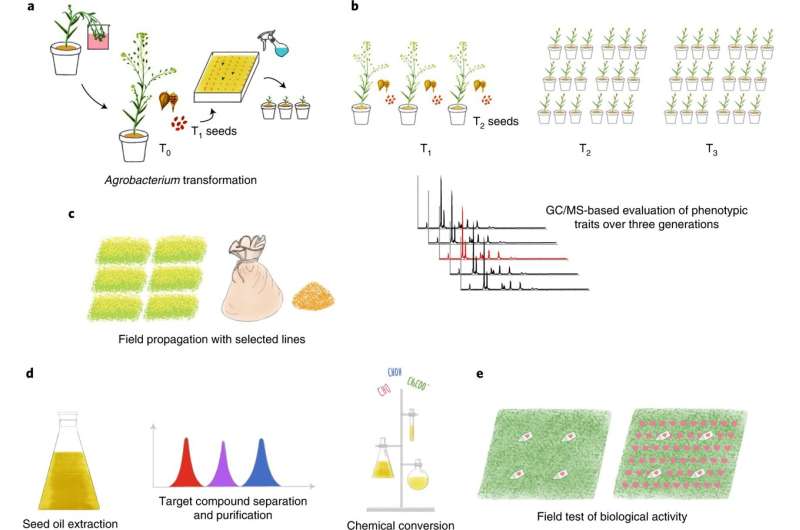Workflow of the production of a transgenic line of Camelina sativa. a, Agrobacterium tumefaciens-mediated gene transfer by floral dip technique. b, Breeding of positively transformed lines over three generations (T1–T3) based on seed fatty acid GC/MS analysis. c, Propagation of selected lines in field trials. d, Seed oil extraction, target compound isolation and purification and chemical conversion of the precursor acid into pheromone compounds. e, Bioactivity evaluation in field trapping and trap shutdown experiments. Credit: Nature Sustainability (2022). DOI: 10.1038/s41893-022-00949-x
A team of researchers from Sweden, China and the U.S. has developed a much cheaper way to produce pheromones as a crop pest repellent. In their paper published in the journal Nature Sustainability, the group describes how they genetically altered a plant to force it to produce a pheromone that could be used as a pest repellent. Johnathan Napier with Rothamsted Research, in the U.K., has published a News & Views piece in the same journal issue outlining the work done by the team on this new effort.
As the dangers of using pesticides on crops become more apparent, scientists have ramped up efforts to find safer alternatives. In this new effort, the researchers took another look at using pheromones.
Most pesticides work by killing the pests that feed on crop plants. While efficient, such chemicals have also been found to kill beneficial insects such as pollinators. One safer alternative that has been tried is the use of pheromones. Such chemicals are produced by bugs to attract mates. Flooding an area with artificially made chemicals confuses the bugs and prevents them from mating. Unfortunately, making pheromones on an industrial scale has proven to be too expensive. In this new effort, the researchers took a new approach—engineering a plant to produce them.
The work involved studying the genes of a certain pest and finding which are responsible for pheromone production. They next cut those DNA strands from the bugs' genome and added them to the genome of a plant. The plant the team used was the camelina, which is an oilseed crop—they engineered it to produce pheromones produced by two types of moths that feast on a wide variety of crop plants during their caterpillar stage.
The researchers planted a small field with their engineered plants and then measured the amounts of pheromones. Finding success, they extracted the pheromones from the plants they had produced and applied the results to pheromone traps. The traps were then placed in agricultural test sites to see if they would confuse the pests threatening the crops. The researchers found that they worked as well as commercially made pheromones—at a much lower cost.
More information: Hong-Lei Wang et al, Insect pest management with sex pheromone precursors from engineered oilseed plants, Nature Sustainability (2022). DOI: 10.1038/s41893-022-00949-x
Johnathan A. Napier, Something in the air, Nature Sustainability (2022). DOI: 10.1038/s41893-022-00954-0
Journal information: Nature Sustainability
© 2022 Science X Network























